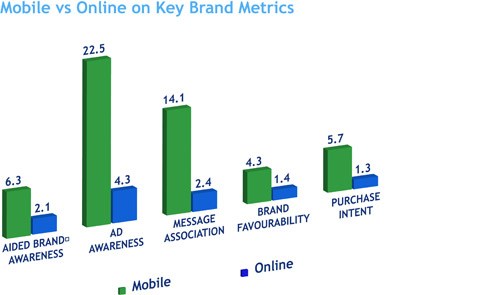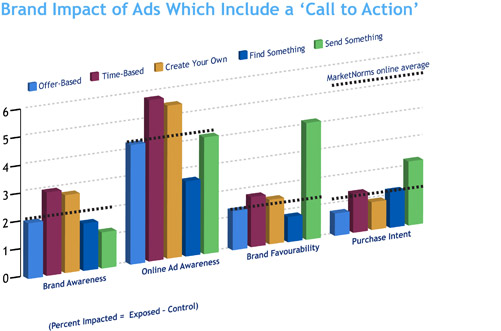A new path to brand affinity? |
 |
|
James MacCarthy-Morrogh on how marketers can best leverage mobile advertising for their brands |
The Smartphone is potentially the perfect advertising portal and has the potential to enable perfect message targeting in terms of demographic group and, most importantly, location in real time. It is projected that US advertising spend on mobile will exceed $1 billion this year. This is set to increase exponentially as critical mass is reached and more advertisers put their faith in the medium. Millward Brown has found from its studies that this faith is justified.

Our normative data indicates that mobile advertising has a positive effect on many of the key brand metrics (see chart 1). On average, mobile marketing tends to outperform standard online campaigns. In particular, the impact on purchase intent is five times that of comparable online campaigns. It is a compelling statistic and should whet the appetite of marketers for more in-depth studies into the effectiveness of their online spend and mobile in particular.
What drives this success rate? Many might have thought of mobile advertising as at best an unwelcome distraction to people as they ‘social network’ one another on their iPhones or tablets, or at worst an invasion of privacy as geo-located advertising follows people around the shopping mall – popping up on their phones as they walk past the stores and restaurants? Not so. Much of the mobile advertisings success is attributable to the following factors.
- Because mobile marketing can be better targeted it is likely to be a major contributor to its impact as it already reaches an engaged audience.
- Unlike its online cousin, mobile marketing is a relatively uncluttered medium – with a larger proportion of the screen being taken up by the ad.
- Better focused ad copy is required due to the size and technology constraints of the medium
Within these parameters, Millward Brown identified three characteristics closely associated with high impact mobile advertising that should form the backbone of any mobile campaign.
- Left side brand placement – this has a high correlation with brand recall. This is the part of the screen that the eye is automatically drawn to first – even those who only briefly glimpse the creative will have a higher level of brand recall because of this.
- It seems like an obvious point, put consistent branding is also key for effective online advertising. Clear branding on each frame within a creative sequence is a common factor of those ads that performed best across the brand metrics, as opposed to those where branding was not consistent throughout.

- A ‘call- to-action’ is a common trait among the ads that had the best impact on purchase intention. These ads have the ability to hold the attention of the consumer for longer, engage interaction and are more likely to incentivise purchase.
In-depth research of these ‘call–to-action’ messages has revealed further insights into how they are best used to drive purchase. There are a number of sub-categories that Millward Brown uses in this analysis and they provide further guidance to the advertiser. (See chart 2)
- Offer based
- Time based
- Create your own (customize a product)
- Find something (enter your post code to find a restaurant)
- Send something (share this with a friend)
Each call to action has different strengths. The time based ad is best at impacting awareness – probably due to the sense of urgency it can imbue. The ‘create’ or ‘send’ options are best at driving brand favourability and to a lesser degree purchase intent, as these prompt the viewer to immediate further action (sending it to someone) and tap into the use of social networks.
The ads’ analysis noted that humour is a top factor in the success of a campaign going viral by such means. Above all, the research reveals that the message must be simple and if possible interactive in some way – so that the consumer feels they are gaining something.
Who are mobile campaigns most likely to reach? Not surprisingly, younger age cohorts react best and have the highest persuasion rates. But awareness rates are much less prone to reveal differences across age groups, indicating how brand awareness can be built across a wide demographic range using this platform. Mobile campaigns tend to be more successful with females and those in the higher income brackets.
FMCG ads perform best in awareness and persuasion – their ability to convey a simple logo/product or brand message is advantageous in this medium and women strongly outperform men in terms of purchase intent in this category.
It is an evolving marketplace and there is much yet to learn about how brands perform on mobile devices. International learnings to date suggest it is going to become an increasingly important element of marketing and digital spend and it will be critical to understand how this advertising channel is delivering for its brands.
James MacCarthy-Morrogh is account director with Millward Brown Lansdowne









